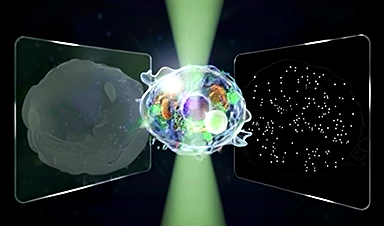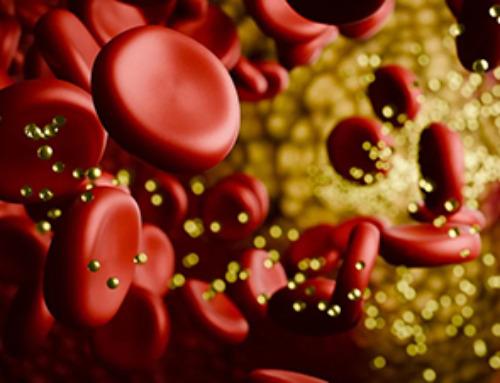A predictive model has been developed that enables researchers to encode instructions for cells to execute.
Scientists at the University of California, San Francisco (UCSF) and IBM Research have created a virtual library of thousands of "command sentences" for cells using machine learning. These "sentences" are based on combinations of "words" that direct engineered immune cells to find and continuously eliminate cancer cells.
This research, which was recently published in the journal Science, is the first time that advanced computational techniques have been applied to a field that has traditionally progressed through trial-and-error experimentation and the use of pre-existing molecules rather than synthetic ones to engineer cells.
The advance allows scientists to predict which elements – natural or synthesized – they should include in a cell to give it the precise behaviors required to respond effectively to complex diseases.
Meet the Molecular Words That Make Cellular Command Sentences
Much of therapeutic cell engineering involves choosing or creating receptors that, when added to the cell, will enable it to carry out a new function. Receptors are molecules that bridge the cell membrane to sense the outside environment and provide the cell with instructions on how to respond to environmental conditions.
Putting the right receptor into a type of immune cell called a T cell can reprogram it to recognize and kill cancer cells. These so-called chimeric antigen receptors (CARs) have been effective against some cancers but not others.
Lim and lead author Kyle Daniels, Ph.D., a researcher in Lim's lab, focused on the part of a receptor located inside the cell, containing strings of amino acids, referred to as motifs. Each motif acts as a command "word," directing an action inside the cell. How these words are strung together into a "sentence" determines what commands the cell will execute.
Many of today's CAR-T cells are engineered with receptors instructing them to kill cancer, but also to take a break after a short time, akin to saying, "Knock out some rogue cells and then take a breather." As a result, the cancers can continue growing.
The team believed that by combining these "words" in different ways, they could generate a receptor that would enable the CAR-T cells to finish the job without taking a break. They made a library of nearly 2,400 randomly combined command sentences and tested hundreds of them in T cells to see how effective they were at striking leukemia.
What the Grammar of Cellular Commands Can Reveal About Treating Disease
Next, Daniels partnered with computational biologist Simone Bianco, Ph.D., a research manager at IBM Almaden Research Center at the time of the study and now Director of Computational Biology at Altos Labs. Bianco and his team, researchers Sara Capponi, Ph.D., also at IBM Almeden, and Shangying Wang, Ph.D., who was then a postdoc at IBM and is now at Altos Labs, applied novel machine learning methods to the data to generate entirely new receptor sentences that they predicted would be more effective.
"We changed some of the words of the sentence and gave it a new meaning," said Daniels. "We predictively designed T cells that killed cancer without taking a break because the new sentence told them, 'Knock those rogue tumor cells out, and keep at it.'"
Pairing machine learning with cellular engineering creates a synergistic new research paradigm.
"The whole is definitely greater than the sum of its parts," Bianco said. "It allows us to get a clearer picture of not only how to design cell therapies, but to better understand the rules underlying life itself and how living things do what they do."
Given the success of the work, added Capponi, "We will extend this approach to a diverse set of experimental data and hopefully redefine T-cell design."
The researchers believe this approach will yield cell therapies for autoimmunity, regenerative medicine, and other applications. Daniels is interested in designing self-renewing stem cells to eliminate the need for donated blood.
He said the real power of the computational approach extends beyond making command sentences, to understanding the grammar of the molecular instructions.
"That is the key to making cell therapies that do exactly what we want them to do," Daniels said. "This approach facilitates the leap from understanding the science to engineering its real-life application."
News
New mRNA therapy targets drug-resistant pneumonia
Bacteria that multiply on surfaces are a major headache in health care when they gain a foothold on, for example, implants or in catheters. Researchers at Chalmers University of Technology in Sweden have found [...]
Current Heart Health Guidelines Are Failing To Catch a Deadly Genetic Killer
New research reveals that standard screening misses most people with a common inherited cholesterol disorder. A Mayo Clinic study reports that current genetic screening guidelines overlook most people who have familial hypercholesterolemia, an inherited disorder that [...]
Scientists Identify the Evolutionary “Purpose” of Consciousness
Summary: Researchers at Ruhr University Bochum explore why consciousness evolved and why different species developed it in distinct ways. By comparing humans with birds, they show that complex awareness may arise through different neural architectures yet [...]
Novel mRNA therapy curbs antibiotic-resistant infections in preclinical lung models
Researchers at the Icahn School of Medicine at Mount Sinai and collaborators have reported early success with a novel mRNA-based therapy designed to combat antibiotic-resistant bacteria. The findings, published in Nature Biotechnology, show that in [...]
New skin-permeable polymer delivers insulin without needles
A breakthrough zwitterionic polymer slips through the skin’s toughest barriers, carrying insulin deep into tissue and normalizing blood sugar, offering patients a painless alternative to daily injections. A recent study published in the journal Nature examines [...]
Multifunctional Nanogels: A Breakthrough in Antibacterial Strategies
Antibiotic resistance is a growing concern - from human health to crop survival. A new study successfully uses nanogels to target and almost entirely inhibit the bacteria P. Aeruginosa. Recently published in Angewandte Chemie, the study [...]
Nanoflowers rejuvenate old and damaged human cells by replacing their mitochondria
Biomedical researchers at Texas A&M University may have discovered a way to stop or even reverse the decline of cellular energy production—a finding that could have revolutionary effects across medicine. Dr. Akhilesh K. Gaharwar [...]
The Stunning New Push to Protect the Invisible 99% of Life
Scientists worldwide have joined forces to build the first-ever roadmap for conserving Earth’s vast invisible majority—microbes. Their new IUCN Specialist Group reframes conservation by elevating microbial life to the same urgency as plants and [...]
Scientists Find a Way to Help the Brain Clear Alzheimer’s Plaques Naturally
Scientists have discovered that the brain may have a built-in way to fight Alzheimer’s. By activating a protein called Sox9, researchers were able to switch on star-shaped brain cells known as astrocytes and turn them into [...]
Vision can be rebooted in adults with amblyopia, study suggests
Temporarily anesthetizing the retina briefly reverts the activity of the visual system to that observed in early development and enables growth of responses to the amblyopic eye, new research shows. In the common vision [...]
Ultrasound-activated Nanoparticles Kill Liver Cancer and Activate Immune System
A new ultrasound-guided nanotherapy wipes out liver tumors while training the immune system to keep them from coming back. The study, published in Nano Today, introduces a biodegradable nanoparticle system that combines sonodynamic therapy and cell [...]
Magnetic nanoparticles that successfully navigate complex blood vessels may be ready for clinical trials
Every year, 12 million people worldwide suffer a stroke; many die or are permanently impaired. Currently, drugs are administered to dissolve the thrombus that blocks the blood vessel. These drugs spread throughout the entire [...]
Reviving Exhausted T Cells Sparks Powerful Cancer Tumor Elimination
Scientists have discovered how tumors secretly drain the energy from T cells—the immune system’s main cancer fighters—and how blocking that process can bring them back to life. The team found that cancer cells use [...]
Very low LDL-cholesterol correlates to fewer heart problems after stroke
Brigham and Women's Hospital's TIMI Study Group reports that in patients with prior ischemic stroke, very low achieved LDL-cholesterol correlated with fewer major adverse cardiovascular events and fewer recurrent strokes, without an apparent increase [...]
“Great Unified Microscope” Reveals Hidden Micro and Nano Worlds Inside Living Cells
University of Tokyo researchers have created a powerful new microscope that captures both forward- and back-scattered light at once, letting scientists see everything from large cell structures to tiny nanoscale particles in a single shot. Researchers [...]
Breakthrough Alzheimer’s Drug Has a Hidden Problem
Researchers in Japan found that although the Alzheimer’s drug lecanemab successfully removes amyloid plaques from the brain, it does not restore the brain’s waste-clearing system within the first few months of treatment. The study suggests that [...]





















